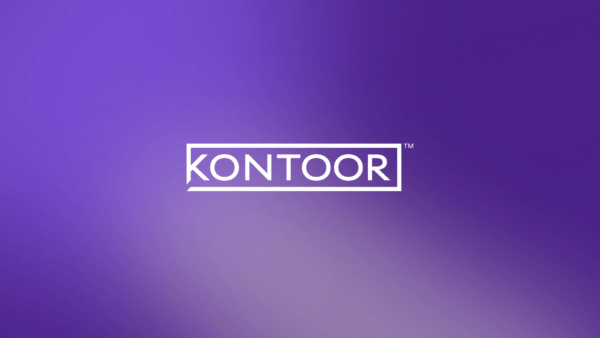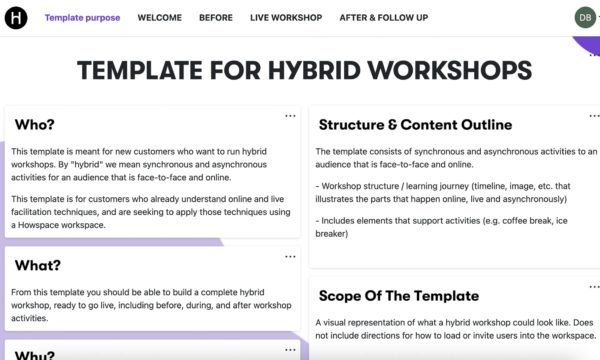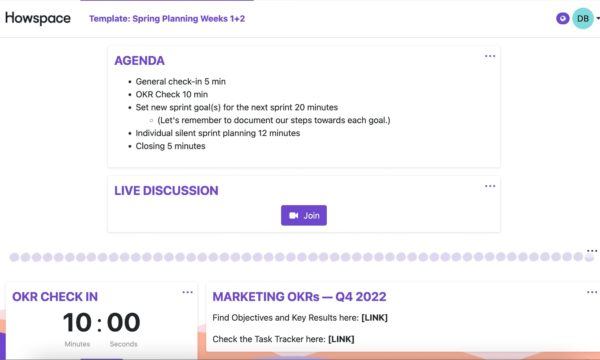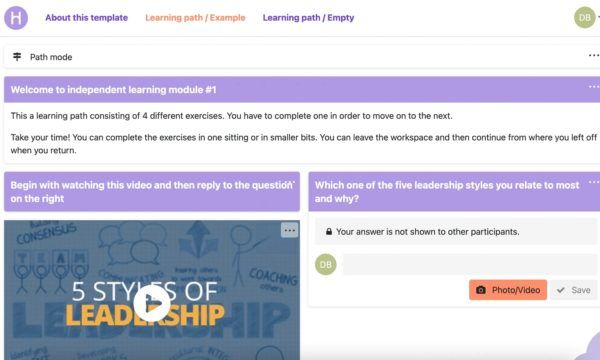Optimé International
Embracing change and leading the way forward for the future of training
Challenge
Before digitalizing their services, Optimé mainly ran in-person training with groups of between 40 to 300 people. Their main challenge was to preserve the “magic” from these in-person learning experiences when delivering training online.
Solution
To work through this challenge, Optimé enrolled all their facilitators in a training program on how to facilitate virtually, where they learned a couple of valuable lessons:
Results
Like all training organizations, Optimé International didn’t have a playbook for figuring out virtual training when COVID-19 upended life as we knew it.
“A year ago, our world was upset in a very big way, and we were in a pretty big “figure-it-out” stage,” says Allen Bessel, Senior Vice President of Client Experience at Optimé International. “But what we have evolved to at Optimé is better than what we left, and Howspace was an integral part of how we transformed.”
By letting go of traditional training methods and working with Howspace, Optimé not only survived the paradigm shifts brought about by COVID-19, but has been thriving in this new way of working.
Two lessons learned about digital facilitation
Before COVID-19, Optimé mainly ran in-person training with groups of between 40 to 300 people. Their main challenge was to preserve the “magic” from these in-person learning experiences when delivering training online.
“We knew that how we led training in a live classroom wasn’t going to work the same way online,” says Allen.
To work through this challenge, Optimé enrolled all their facilitators in a training program on how to facilitate virtually, where they learned a couple of valuable lessons:
Work with a producer
“All of us now work with a producer when facilitating online. That allows me as a facilitator to keep the attention of everyone in the room while someone else might work on any technical troubles the participants are having. I can keep my focus on engaging the learners,” explains Allen.
Take a blended learning approach
Optimé discovered how to blend asynchronous, or self-directed, learning with synchronous learning, meaning time spent live with learners.
This led them to redo all of their content: They fit two eight-hour days worth of content into five 90-minute virtual classroom sessions with smaller groups of 20-24 people. For one-day programs, they restructured their content to three 90-minute sessions.
In rethinking their training content, Optimé came up with a set of design principles to help guide their work.
Optimé’s design principles for virtual learning
Put the learner first
Put the learner at the center of all your decisions and consider their needs and time commitments. Ask yourself: What will the experience be like for the learner? For example, if you ran full-day training sessions before COVID-19 as Optimé did, consider how participants would feel staring at a screen for six or eight hours.
“We went from presentation decks designed to teach to almost completely empty whiteboards that we would use to better promote learning.”
“With virtual training, it was about me talking less and facilitating more,” says Allen. “All of our presentation material had to change. We went from presentation decks designed to teach to almost completely empty whiteboards that we would use to better promote learning.”
Allen continues: “We had to be ruthless with our redesign of content: We took out some of our favourite things and focused more tightly on what learners needed to know to take concepts into the field in a short amount of time. When we thought about what value we were bringing to customers, the decision of what’s in and what’s out was much easier.”
Set one to two learning objectives per learning module
Optimé limited what they were trying to accomplish in each 90-minute training module to one or two core learning objectives. “Our tendency was to try to fit as much value into a session as we could. When we tried to do that, we were really diluting everything that we did,” says Allen.
They stayed focused, sharp, and clear on their intentions for what learners should take away from those modules. And all facilitators work hard to make the training meaningful and relatable for participants.
Deliver training in three components per module
Optimé uses Howspace to deliver asynchronous learning before and after their 90-minute live virtual sessions. The asynchronous work participants are asked to do requires only about 30 minutes of their time.
Component 1) Before the virtual classroom time, facilitators deliver theory and models that participants read through on their own time.
Component 2) Live classroom time is spent practising, discussing, and challenging those theories—which is best done live.
Component 3) Facilitators use Howspace again after the live session to deliver tools and practical exercises that participants can apply in the real world.
“Howspace has become an extension of learning both before and after the classroom sessions through peer-to-peer discussions,” summarizes Allen.
Have learners do an activity every three to five minutes
To truly drive engagement in a virtual space, keep your participants active rather than passively listening. For example, ask them to raise their hand, answer a poll, share something in the chat, or join a break-out room.
“You’re managing their physical engagement. Participants feel much more part of the learning when you ask them to contribute in different ways,” says Allen.
Learn how to learn online
To help people who aren’t familiar with technology become more comfortable using it in training, Optimé hosted sessions called “Learn how to learn online”—both for their team and for their customers. These sessions covered the differences between live and virtual classrooms, how learners were expected to participate, and what tools to use.
Now a year into virtual training, Optimé doesn’t have to run those sessions anymore. But if they come across participants who haven’t been in a virtual classroom before, they simply integrate more guidance throughout the exercises.
VIDEO: Allen walks us through an example of how he set up the learner experience at Optimé.
Unlocking imagination and shifting mindsets
For Optimé, shifting their mindset around virtual training was challenging, but massively important.
“It took a lot for us to get out of our own heads about what training looked like and what learning and development had to feel like and how it would be delivered. We cast all that aside when we talked to other experts about what it could be. As we started to see what we could do with Howspace, it unlocked our imagination for us,” explains Allen.
By staying curious and discussing with digital facilitation experts at Howspace, Optimé was able to let go of traditional methods and deliver remarkable training.
“There is nothing I could do in an in-person training session that I can’t do virtually, and in some cases, it’s turned out to be more effective.”
Allen’s advice to organizations that are still in the “figuring it out” stage?
“Think about your perspective: What are you trying to accomplish? Are you trying to replace what you did in the classroom, or are you trying to do what you did in the classroom but in a different way? My perspective today is that there is nothing I could do in an in-person training session that I can’t do virtually, and in some cases, it’s turned out to be more effective.”
For example, Optimé ran experiential learning sessions on Howspace based on the sales simulations they used to run in-person, where salespeople would prepare a scenario based on their real work, and then get feedback from managers. “With Howspace, this was done even easier than in the boardroom. It was super simple, much less disruptive, quicker to deliver, and less expensive,” says Allen.
The benefits of using Howspace for virtual blended learning
Higher engagement levels
Allen summarizes the benefits of moving full-day in-person training sessions to a blended learning model: “Engagement levels are higher and participants are not fatigued by end of the day. We’re working with smaller groups, so I develop better relationships with them throughout the training. Everyone’s on and it feels like a more robust and fulfilling experience for all learners than it did when we had 70 people in a conference room.”
“It feels like a more robust and fulfilling experience for all learners than it did when we had 70 people in a conference room.”
Marty Blake, Chief Operating Officer at Optimé, explains that they first questioned how they would engage learners effectively and allow them to practice what they learned in a short period of time. “Howspace has been a big part of the answer—we use Howspace as a transmitter of knowledge but also to foster engagement.”
To realize these benefits, it’s important for facilitators to let participants know what’s expected of them. Participants are asked to keep their cameras on so that they can better relate to and engage with other learners. They’re also asked to avoid distractions by putting their phone away and not checking email during sessions.
“We collect feedback from learners along the way, and the vast majority—as high as 80- 90%—embrace virtual learning. No one’s hanging on to the days of being in a classroom and I think Howspace contributes to that in a big way,” says Allen.
Support all learning styles
“The beautiful thing about virtual is that the opportunity to participate now extends equally across all learning styles,” says Allen.
At Optimé, they’ve seen participants who they wouldn’t expect to share openly on Howspace.
“There’s something about the workspace in Howspace that creates a safe environment for people to contribute,” says Marty.
Allen explains this happens for two reasons:
- Participants are not put on the spot and expected to answer with no preparation, but they can instead write or record something they’re comfortable with.
- Participants can decide how they want to contribute. They don’t have to speak out loud in front of all their peers, but can instead type in Howspace.
“The quality and depth of sharing far surpasses what we had time for in a live classroom and what people were comfortable to provide,” says Allen.
Adapt training as you go
Another key benefit of Howspace is that it’s allowed Optimé to practice in-the-moment facilitating.
“Howspace hasn’t just made our delivery simpler, but also way more effective because it allows for a lot of just-in-time learning.”
Allen explains: “If you run long on a session and you don’t get to it all, or something comes up that wasn’t planned, you can add that additional information into Howspace and deliver it to them in a moment after the session. We don’t have production times anymore, we’re not printing manuals and setting them up in advance. Howspace hasn’t just made our delivery simpler, but also way more effective because it allows for a lot of just-in-time learning.”
Partnering with Howspace helps Optimé focus on what they do best
Optimé’s ultimate goal is to develop sales talent to be the best. And in partnering with Howspace, they feel they’re working towards the same goal. “It feels like we work together rather than that we’re purchasing something from them. It feels like we’re attempting to deliver the same result,” says Marty.
Marty continues, “We’re not a technology firm, we don’t have a back office of developers, nor do we want to because that’s not what we do best—and we want to stay focused on what we do best. What Howspace offered was a very functional and easy way to build our own training style, to take something and make it our own in many ways.”
Optimé is among the 160+ passionate partners we work with at Howspace, with the shared goal to better engage people.

Similar customer stories
View all
Leading trade union innovation and learning: How Unions 21 enables unions to claim their agency
Discover how Unions 21 empowers trade unions through inclusive, engaging online learning with Howspace—helping them stay connected, adapt to change, and lead renewal across the movement.

Scaling leadership development across continents—without compromising engagement
Discover how Kontoor Brands transformed leadership development across continents with Howspace, improving engagement and creating a stronger global community.

WEA’s online course for digital skill development achieved outstanding engagement compared to typical MOOCs
Learn how WEA Finland utilized Howspace to create an impactful online course, resulting in high engagement rates and empowering participants to enhance their digital skills.
Templates used in similar cases
View all
Design a Hybrid Workshop

2-Week Agile-style Sprint
